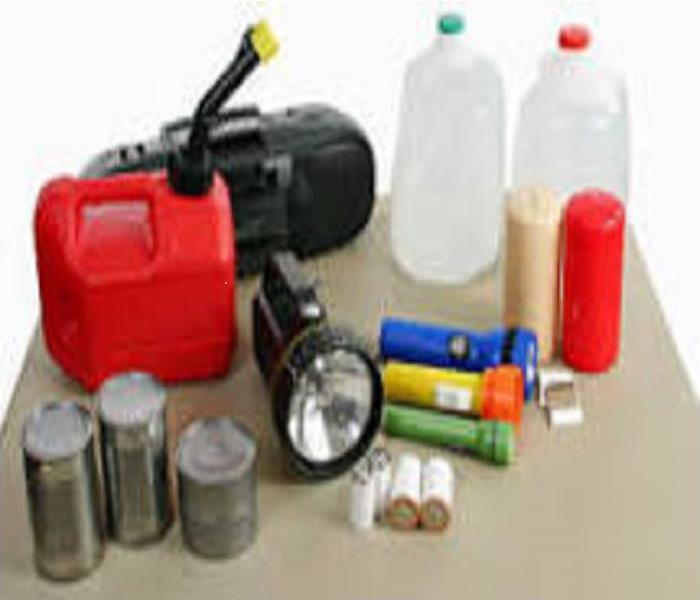Recent Storm Damage Posts
5 Ways to Protect Your Property from Storm Damage
7/18/2022 (Permalink)
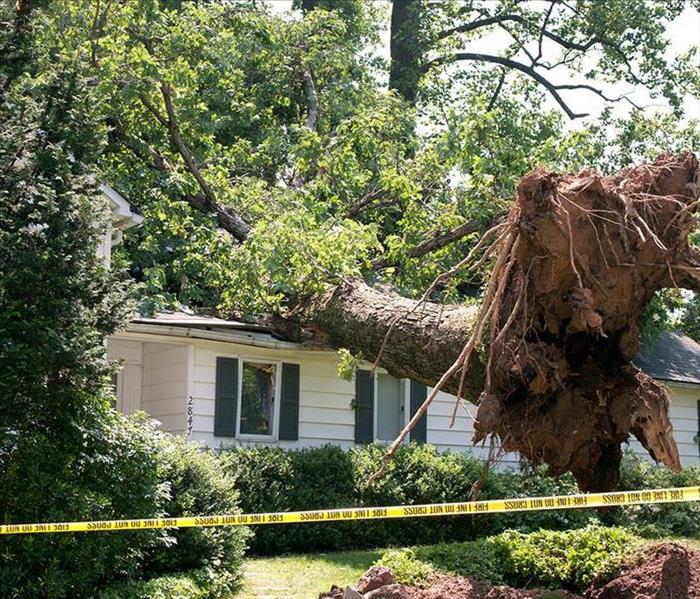 house with down tree from a storm
house with down tree from a storm
Springtime in Wisconsin marks the start of storm season. You never know how severe the storms will be from year to year, but damaged property can be a costly consequence.
Luckily a little bit of planning goes a long way when it comes to minimizing the damage to your home or business. Here are five ways you can keep your property as safe as possible when a storm hits:
- Check for Dead, Decaying, or Untrimmed Trees
Any trees in your yard that are dead, hollowed, or decaying from disease are easy targets for strong winds and rains during a storm. Falling trees can cause significant damage to your property. If you have several trees in your yard, it may be best to hire a tree expert to inspect them.
- Inspect Your Foundation and Roof
Check your home or building’s foundation for any cracks or areas where storm water could seep in. It’s also wise to inspect your roof each year to make sure you catch any minor damage before it can get serious. Do it yourself if you have a proper ladder and safety equipment, or hire a professional. Check for any damaged or missing shingles; if you have siding, it’s good to check and replace any loose pieces, too.
- Clean Your Gutters
Dirty or clogged gutters are a main culprit of water leaks into your basement or home. Make sure they are free from debris so the storm water can safely flow away from your home or building’s foundation.
- Check You Water Flow, Sump Pump, and Shut-Off Situation
Make sure your property is graded to allow water to flow away from your home or building during a storm. It’s good to check that your sump pump is in working order; if it backs up it can cause basement flooding. Know ahead of time how to shut off utilities like your water or power to ensure you’re ready and safer during a severe storm.
- Seal Your Doors and Windows
Keep your doors and windows sealed, as they can be a gateway to major damage in the event of a storm. Severe winds from a tornado can cause a tiny opening in your windows or doors to enlarge and let enough wind inside to cause damage to your walls and roof.
After a Storm Hits, SERVPRO is Here for You
If your property incurs any damage or flooding after a severe thunderstorm or tornado, SERVPRO of Southeast Milwaukee County is here to help. Our team is dedicated to responding immediately to water and storm damage emergencies—this helps lessen the damage, limits further damage, and reduces your costs. Trust our 24/7 service whenever you need us at (414) 421-3500.
Emergency Supply Kit
7/11/2022 (Permalink)
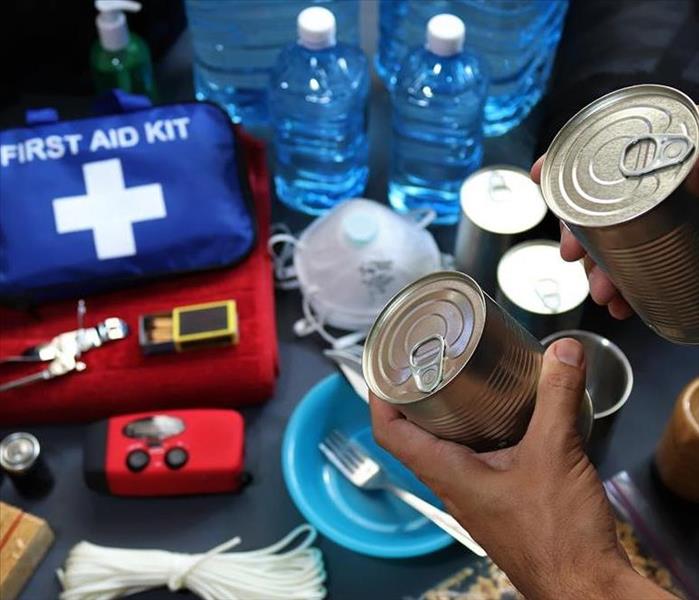 Supplies for an emergency
Supplies for an emergency
Recommended items to include in a basic emergency supply kit:
- Water (one gallon per person per day)
- Food (non-perishable 3-day supply)
- Manual can opener
- Battery operated radio, preferably a NOAA Weather Radio with tone alert and extra batteries)
- Flashlight and extra batteries
- First aid kit
- Whistle to signal for help
- Clothing
- Dust masks or bandanas
- Plastic sheeting, garbage bags and duct tape
- Wrench or pliers to turn off utilities
- Local maps
- Hygiene items
- Important documents such as copies of insurance policies, identification and bank account information.
- Cash
- Fire extinguisher
- Matches in a waterproof container
We hope you never need this list, but it's important to be prepared and make sure everyone in your family knows where to find your emergency kit as well as where your family is going to meet in the event of an emergency.
Watch vs. Warning
2/10/2022 (Permalink)
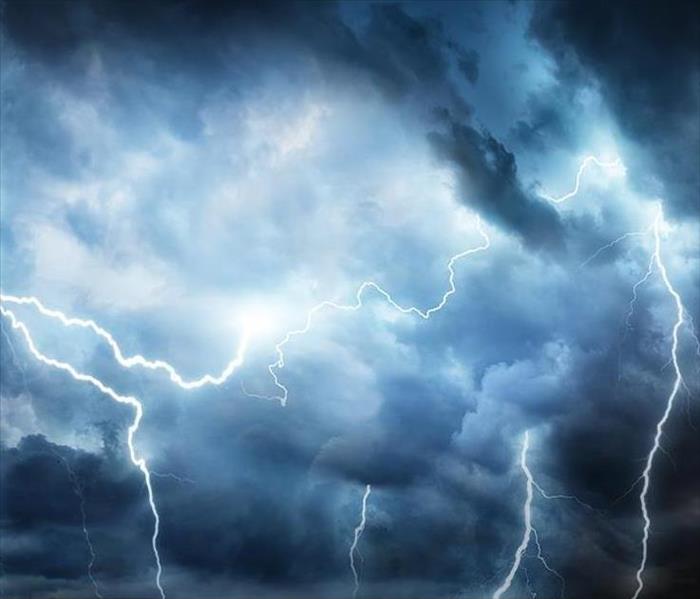 storm clouds
storm clouds
Based on information provided by NOAA (National Oceanic and Atmospheric Administration), please be aware of the following distinctions.
A thunderstorm is a rain shower during which you hear thunder. Since thunder comes from lightning, all thunderstorms have lightning.
A thunderstorm is classified as "severe" when it contains one or more of the following: Hail (one inch or greater), Winds in excess of 58 mph, Structural wind damage or a tornado.
A severe thunderstorm watch means that the potential exists for the development of thunderstorms which may produce large hail or damaging winds. A watch is issued by the SPC (Storm Prediction Center).
A severe thunderstorm warning means that a severe thunderstorm is occurring or is imminent based on Doppler radar information or a reliable spotter report. A warning is issued by the local National Weather Service.
After the Storm
2/10/2022 (Permalink)
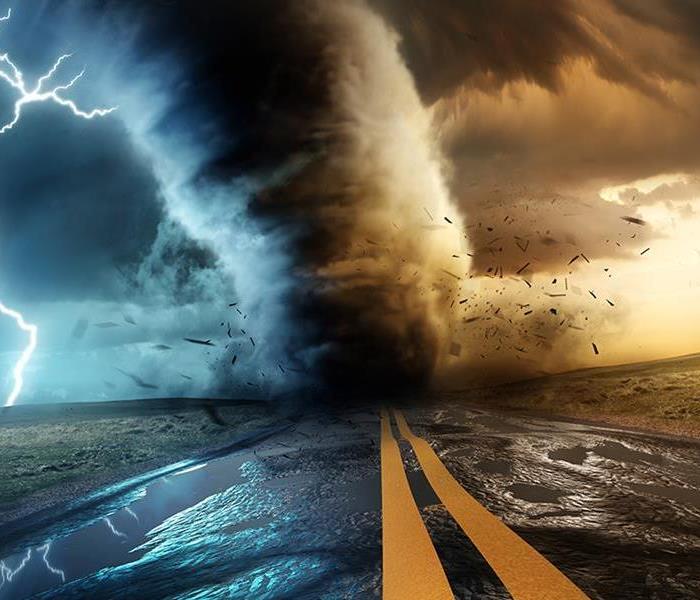 after the storm graphic
after the storm graphic
Be careful to take certain precautions after the store has passed. Damage to your home can have a dramatic, emotional impact, and it's best to have a plan before the store strikes on how to proceed when it's over. Having a plan, and being aware of certain risks, will minimize the threat to you or your family.
Keep these tips in mind:
- Have a portable radio with fresh batteries on hand, and stay tuned to local news organizations for important announcements, bulletins and instructions.
- Remember that you may not have immediate access to your home. Roads could be blocked and power lines could be down.
- Make sure you have current identification.
- Avoid driving as roads may be blocked.
- Avoid sight-seeing or entering a storm affected area
- Avoid downed power lines
- Avoid metal fences and other metal objects
- Do NOT use matches in a store affected area until all gas lines are checked for leaks - keep flashlights and plenty of batteries on hand.
- Use a camera to record thoroughly any damage done to you home before any repairs are attempted.
- In certain areas, the flooding rains that accompany a store can create pest problems. Be aware of potential pest problems in your area., such as mice, rats, insects or snakes that may have "come with the storm".
- Use your phone only for emergencies.
- Assume the water is not safe and use properly store water.
These are just a few ideas to be thinking about before and after a server storm hits.
Make Sure to Stay Safe
1/18/2022 (Permalink)
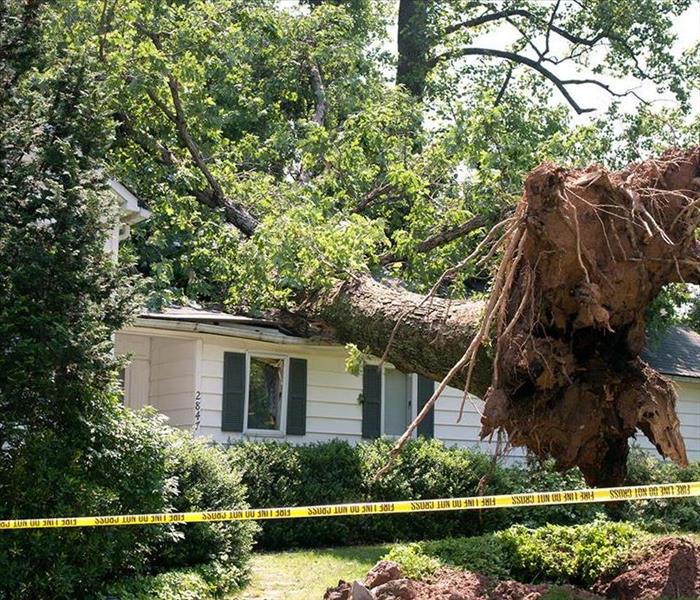 tree that fell on a house
tree that fell on a house
Before entering a building where flood damage may have occurred, make sure it's safe: check for electrical hazards and structural damage, and use proper protective gear like boots, gloves and respirators.
Then follow these tips:
- Act quickly. the severity of damage escalates the longer water sits and building materials stay wet, so time is of the essence. Mold will grow within 48-72 hours, so aim to start removing water and drying the environment within 48 hours.
- Have professionals, like SERVPRO of Southeast Milwaukee County on hand to call and understand your insurance policy.
- Access damage to items and materials along with the type of water absorbed by items, such as rainwater, water from broke pipes, contaminated river water or bacteria-filled sewage.
- Conduct a thorough cleaning. SERVPRO of Southeast Milwaukee County has the equipment and proper cleaning chemicals to clean and sanitize your home as well as the drying equipment to properly dry your home.
Emergency Supply Kit
1/4/2022 (Permalink)
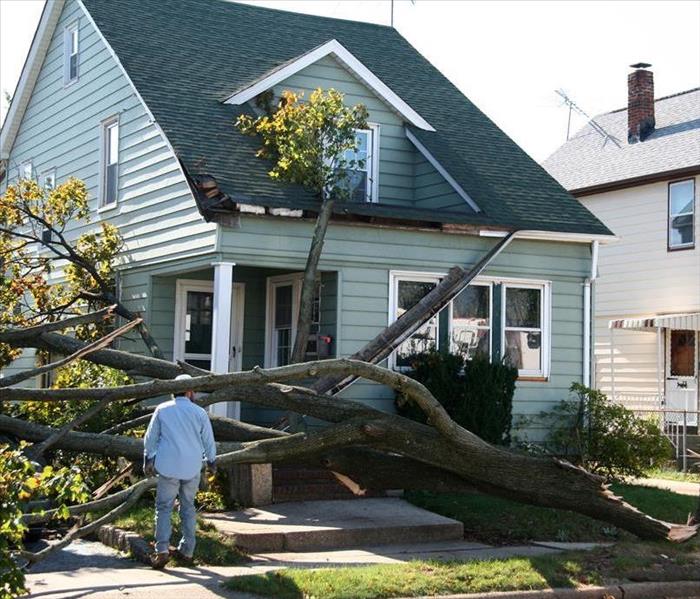 Storm damage
Storm damage
Recommended items to include in a basic emergency supply kit:
- Water (one gallon per person per day)
- Food (non-perishable 3-day supply)
- Manual can opener
- Battery operated radio, preferably a NOAA Weather Radio with tone alert and extra batteries)
- Flashlight and extra batteries
- First aid kit
- Whistle to signal for help
- Clothing
- Dust masks or bandanas
- Plastic sheeting, garbage bags and duct tape
- Wrench or pliers to turn off utilities
- Local maps
- Hygiene items
- Important documents such as copies of insurance policies, identification and bank account information.
- Cash
- Fire extinguisher
- Matches in a waterproof container
We hope you never need this list, but it's important to be prepared and make sure everyone in your family knows where to find your emergency kit as well as where your family is going to meet in the event of an emergency.
Stay High & Dry at Home: Try These Flood Prevention Tips
5/17/2021 (Permalink)
Flooding. Most homeowners don’t think about it much, mainly because it’s not a pleasant topic to think about. One way to help you think and worry about it even less is to consider these ways you can prevent a flood occurrence from happening…
First and Foremost: Flood Insurance!
Most homeowners mistakenly think that their insurance policy automatically covers floods—it doesn’t! Check with your insurance provider—if you live in a high-risk flood area, you may want to consider purchasing additional flood coverage.
Assemble an Emergency Kit
If you are in an area that’s prone to flooding or severe storms, it’s a good idea to have an emergency kit on hand. Your kit should include: extra clothes for you and your loved ones; insurance information (policy numbers, agent contact info, etc.); toiletries; and enough cash to last you for a few days.
Fix Your Foundation and Seal Windows
If you spot any cracks in your home’s foundation, cover them with mortar or masonry caulk that you can buy from your local hardware store. It’s also good to purchase sealants that you can apply to walls and windows to keep any storm water from penetrating into your home.
Consider a Battery-Powered Sump Pump
Sump pumps already protect your home from flooding by pumping water out, but of course they are rendered useless if your power goes out in a storm. That’s why a battery-powered sump pump is a great solution—be sure to keep it fully charged during the severe storm season.
Have Your Lawn Graded Properly
Make sure your lawn is graded so that water moves away rather than pools towards your home. Standing storm water near your home can easily seep into your basement windows and foundation. If you’re not sure about how to grade your lawn on your own, hire a landscaping professional.
If flooding causes damage to your home or property, follow these steps until professional help from our SERVPRO of Southeast Milwaukee County team arrives.
5 Ways to Protect Your Property from Storm Damage
5/3/2021 (Permalink)
Springtime in Wisconsin marks the start of storm season. You never know how severe the storms will be from year to year, but damaged property can be a costly consequence.
Luckily a little bit of planning goes a long way when it comes to minimizing the damage to your home or business. Here are five ways you can keep your property as safe as possible when a storm hits:
- Check for Dead, Decaying, or Untrimmed Trees
Any trees in your yard that are dead, hollowed, or decaying from disease are easy targets for strong winds and rains during a storm. Falling trees can cause significant damage to your property. If you have several trees in your yard, it may be best to hire a tree expert to inspect them.
- Inspect Your Foundation and Roof
Check your home or building’s foundation for any cracks or areas where storm water could seep in. It’s also wise to inspect your roof each year to make sure you catch any minor damage before it can get serious. Do it yourself if you have a proper ladder and safety equipment, or hire a professional. Check for any damaged or missing shingles; if you have siding, it’s good to check and replace any loose pieces, too.
- Clean Your Gutters
Dirty or clogged gutters are a main culprit of water leaks into your basement or home. Make sure they are free from debris so the storm water can safely flow away from your home or building’s foundation.
- Check You Water Flow, Sump Pump, and Shut-Off Situation
Make sure your property is graded to allow water to flow away from your home or building during a storm. It’s good to check that your sump pump is in working order; if it backs up it can cause basement flooding. Know ahead of time how to shut off utilities like your water or power to ensure you’re ready and safer during a severe storm.
- Seal Your Doors and Windows
Keep your doors and windows sealed, as they can be a gateway to major damage in the event of a storm. Severe winds from a tornado can cause a tiny opening in your windows or doors to enlarge and let enough wind inside to cause damage to your walls and roof.
After a Storm Hits, SERVPRO is Here for You
If your property incurs any damage or flooding after a severe thunderstorm or tornado, SERVPRO of Southeast Milwaukee County is here to help. Our team is dedicated to responding immediately to water and storm damage emergencies—this helps lessen the damage, limits further damage, and reduces your costs. Trust our 24/7 service whenever you need us at (414) 421-3500.
How basements can flood during the winter?
2/10/2021 (Permalink)
With the temperatures dropping and things freezing over, how is it that basements can spring leaks and flood still?
The most common causes of basement flooding and the resulting water damage during the winter months include ice floes and blocked drains due to snow. When a major snowstorm or ice storm happens, all of the surrounding area melts, and the water needs somewhere to go. If a portion of your yard has melted and the rest has not, the water might find its way into your basement or home as a result of the ice blocking typical drainage methods. Whenever a snowstorm happens, you should always make sure that gutters and drains are clear of ice so that all water can drain as it needs to.
the #1 priority is this still mitigating the damage and limiting the amount of restoration involved. As always, professionals should be called and involved as soon as possible.
February in Wisconsin and how to be ready
2/9/2021 (Permalink)
Winterize Your Home
Winter storms can range from a brief period of extreme cold temperatures, to days of snow, blowing wind and white-out conditions. Preparing in advance helps you tackle winter weather before it even begins. Two of the biggest safety issues as the winter season approaches is knowing how to deal with power outages in cold weather and understanding how to drive (or when not to drive) in snowy conditions.
Get Your Home Winter Ready
- Winterize your home to extend the life of your fuel supply by insulating walls and attics, caulking and weather-stripping doors and windows, and installing storm windows or covering windows with plastic
- Winterize your house, barn, shed or any other structure that may provide shelter for your family, neighbors, livestock or equipment
- Clear rain gutters; repair roof leaks and cut away tree branches that could fall on a house or other structure during a storm
- Maintain heating equipment and chimneys by having them cleaned and inspected every year
- Insulate pipes with insulation or newspapers and plastic and allow faucets to drip a little during cold weather to avoid freezing; Running water, even at a trickle, helps prevent pipes from freezing
- All fuel-burning equipment should be vented to the outside and kept clear
- Keep fire extinguishers on hand and make sure everyone in your house knows how to use them
- Learn how to shut off water valves (in case a pipe bursts)
- Insulate your home by installing storm windows or covering windows with plastic from the inside to keep cold air out
Why Storm Damage is Devastating
1/21/2021 (Permalink)
Storms and Floods devastate different regions every year. Unfortunately, some of the biggest dangers caused by storms can occur after the storm has already passed. In addition to a lack of supplies and road closures, the standing flood water resulting from storms can cause serious health risks. Here are some of the most severe problems floods can bring.
Health Dangers
Standing flood water is teeming with health risks. The CDC has a section detailing all of the possible diseases that become more likely in the event of a storm disaster, including Norovirus and the West Nile Virus. Bacterial infections and diseases become a greater possibility because flood water can infect everything it touches. This can include anything from articles of clothing to the toys that children play with. For this reason, it is incredibly important not to drink or eat anything that has been contaminated by standing flood water, and to always wash hands as often as possible- especially before meals. In addition, open wounds pose a far greater risk of becoming infected as a result of storm waters. If at all possible, keep open wounds out of the water or cover with waterproof bandages.
Physical Hazards
Disease isn't the only invisible hazard that can exist within standing water. Murky water can conceal dangerous insects or even threatening animals beneath the surface. Much of this depends on the location of the storm, but it's not unheard of for alligators to make use of a new habitat resulting from a storm. In addition, much of the physical damage caused by a storm is still present in the water. This can include broken glass or sharp metal which might be impossible to see before it causes injury. On top of that, storms frequently cause damage to power lines. These can lead to a risk of electrocution in standing water.
Your Source for Emergency Relief When a Home Disaster Hits
11/11/2020 (Permalink)
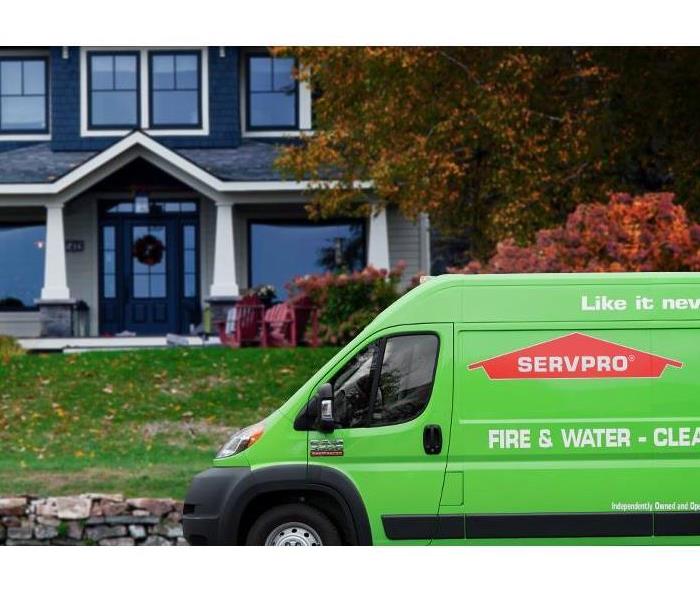 SERVPRO truck
SERVPRO truck
They’re scenes no one wants to come home to: Rivers on your kitchen floor from a leaky dishwasher. An inch of water in your basement after a torrential downpour. A fallen tree that landed on your garage after a severe storm. But there’s one source that can rescue you from all these scenarios—SERVPRO of Southeast Milwaukee County. Regardless of the disaster or the time it happens, our trained restoration pros have the equipment and know-how to help you 24/7.
Disaster never strikes on schedule—SERVPRO is ready around the clock.
Everyone knows that a disaster wouldn’t be a disaster if we knew when it was coming. Middle of the night, while on vacation, late morning while everyone is away at school and/or work…disasters like a tornado or flash flood strike when we least expect them.
Luckily, your neighborhood SERVPRO team is just a call away to fight your next emergency restoration battle. Whether you’re dealing with flooding, water damage, fire, mold, or smoke, SERVPRO of Southeast Milwaukee County is available to you 24/7 with the technicians and advanced technology to return your property back to its original state.
While disaster restoration jobs may take time, our emergency response doesn’t make you wait. Contact us 24 hours a day, 7 days a week, including holidays, and we’ll be there. Expect an immediate response time from us, day or night, because we pride ourselves in our ability to assist you when you need us most.
At SERVPRO of Southeast Milwaukee County, we respond to disaster scenarios immediately because it enables us to minimize the damage that occurs and reduce your restoration and repair costs. Water can be particularly invasive, and precious minutes can accumulate higher costs and more extensive damage if it’s not addressed from the onset.
We are staffed and equipped to respond to emergencies on any size scale at both residential and commercial properties. Even if you have an inkling of an emergency on your hands, and our disaster restoration team will be there before you know it. As they say, it’s always better to be safe than sorry. Simply call 414-421-3500 and we’ll be on our way.
SERVPRO is there for non-emergencies, too.
There are times when cleaning and restoration is necessary but not an urgent response to a disaster situation. That’s why homes and businesses throughout Southeast Milwaukee County trust SERVPRO for everything from cleaning and sanitizing to fire damage and mold remediation. Contact us for a complimentary consultation and estimate—we look forward to serving you.
Make sure it's safe
10/30/2017 (Permalink)
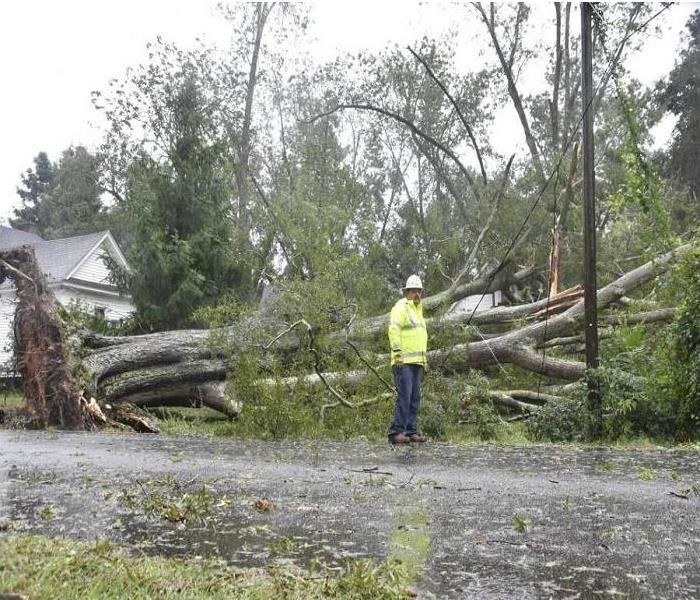 Storm Damage
Storm Damage
Before entering a building where flood damage may have occurred, make sure it's safe: check for electrical hazards and structural damage, and use proper protective gear like boots, gloves and respirators.
Then follow these tips:
- Act quickly. the severity of damage escalates the longer water sits and building materials stay wet, so time is of the essence. Mold will grow within 48-72 hours, so aim to start removing water and drying the environment within 48 hours.
- Have professionals, like SERVPRO of Southeast Milwaukee County on hand to call and understand your insurance policy.
- Access damage to items and materials along with the type of water absorbed by items, such as rainwater, water from broke pipes, contaminated river water or bacteria-filled sewage.
- Conduct a thorough cleaning. SERVPRO of Southeast Milwaukee County has the equipment and proper cleaning chemicals to clean and sanitize your home as well as the drying equipment to properly dry your home.
Fall Safety Check List
10/27/2017 (Permalink)
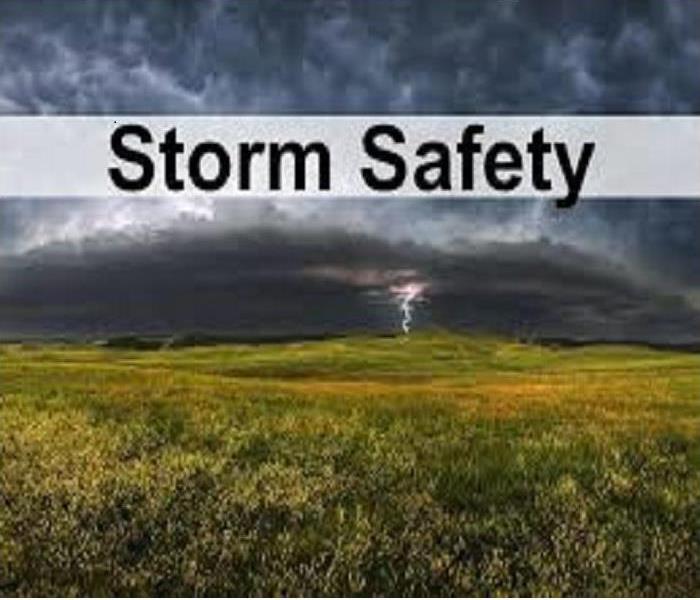 Fall Safety
Fall Safety
Fall is the perfect time of the year to prepare your home for cold weather and ensuring your home is as safe as possible. So take advantage of the somewhat warmer weather (comparatively speaking) and follow the Fall Safety Check list below.
Here is a Fall Safety Check List:
- Change the batteries in all smoke detectors (you should have one on every level of your home)
- Change the batteries in all carbon monoxide monitors (you should have one on every level of your home)
- Check all vents for any debris
- Check fireplaces for any debris
- Winterize your outdoor faucets
- Check trees for any broken limbs
- Double check your gutters for debris
- Check your furnace filters
SERVPRO of Southeast Milwaukee County wants you and your family to stay safe. If you have an emergency, please give us a call. We can be on site quickly and have the equipment and expertise to take care of your water or fire cleanup.
SERVPRO of Southeast Milwaukee County "Like it never even happened."
After the Storm
9/22/2017 (Permalink)
Be careful to take certain precautions after the store has passed. Damage to your home can have a dramatic, emotional impact, and it's best to have a plan before the store strikes on how to proceed when it's over. Having a plan, and being aware of certain risks, will minimize the threat to you or your family.
Keep these tips in mind:
- Have a portable radio with fresh batteries on hand, and stay tuned to local news organizations for important announcements, bulletins and instructions.
- Remember that you may not have immediate access to your home. Roads could be blocked and power lines could be down.
- Make sure you have current identification.
- Avoid driving as roads may be blocked.
- Avoid sight-seeing or entering a storm affected area
- Avoid downed power lines
- Avoid metal fences and other metal objects
- Do NOT use matches in a store affected area until all gas lines are checked for leaks - keep flashlights and plenty of batteries on hand.
- Use a camera to record thoroughly any damage done to you home before any repairs are attempted.
- In certain areas, the flooding rains that accompany a store can create pest problems. Be aware of potential pest problems in your area., such as mice, rats, insects or snakes that may have "come with the storm".
- Use your phone only for emergencies.
- Assume the water is not safe and use properly store water.
These are just a few ideas to be thinking about before and after a server storm hits.
Watch vs Warning
8/28/2017 (Permalink)
 Photo courtesy of Earth Networks
Photo courtesy of Earth Networks
Based on information provided by NOAA (National Oceanic and Atmospheric Administration), please be aware of the following distinctions.
A thunderstorm is a rain shower during which you hear thunder. Since thunder comes from lightning, all thunderstorms have lightning.
A thunderstorm is classified as "severe" when it contains one or more of the following: Hail (one inch or greater), Winds in excess of 58 mph, Structural wind damage or a tornado.
A severe thunderstorm watch means that the potential exists for the development of thunderstorms which may produce large hail or damaging winds. A watch is issued by the SPC (Storm Prediction Center).
A severe thunderstorm warning means that a severe thunderstorm is occurring or is imminent based on Doppler radar information or a reliable spotter report. A warning is issued by the local National Weather Service.
Emergency Supply Kit
8/28/2017 (Permalink)
Recommended items to include in a basic emergency supply kit:
- Water (one gallon per person per day)
- Food (non-perishable 3-day supply)
- Manual can opener
- Battery operated radio, preferably a NOAA Weather Radio with tone alert and extra batteries)
- Flashlight and extra batteries
- First aid kit
- Whistle to signal for help
- Clothing
- Dust masks or bandanas
- Plastic sheeting, garbage bags and duct tape
- Wrench or pliers to turn off utilities
- Local maps
- Hygiene items
- Important documents such as copies of insurance policies, identification and bank account information.
- Cash
- Fire extinguisher
- Matches in a waterproof container
We hope you never need this list, but it's important to be prepared and make sure everyone in your family knows where to find your emergency kit as well as where your family is going to meet in the event of an emergency.
Hurricane Harvey
8/25/2017 (Permalink)
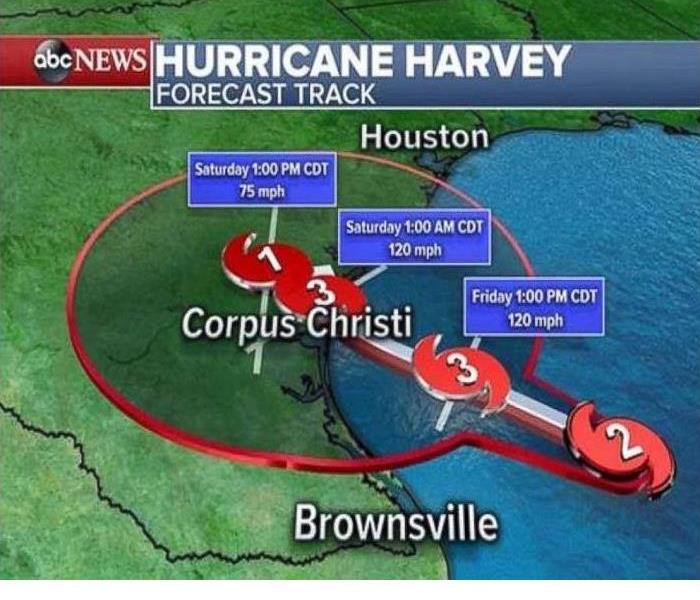 Path of the Hurricane Harvey
courtesy of CNN Weather
Path of the Hurricane Harvey
courtesy of CNN Weather
Harvey is strengthening to a major hurricane with winds approaching 125 mph and is approaching Corpus Christi, Texas. Residents are being encouraged to evacuate due to record-setting flooding. Our thoughts are with the residents of Texas and Louisiana as they go through the first major hurricane since 2005.
We had a taste of the damage water can cause when we had our flooding in July down in Burlington and Kenosha. We have lived through rebuilding our homes and businesses. We can't even imagine the damage a Class 3 hurricane can cause, but we certainly can understand a little of what those residents and business owners are going through.
SERVPRO of Southeast Wisconsin wants to send our thoughts and strength to everyone. We want you to know that we care about you and your family and friends that are here and worrying about your safety.
We also know that when it's time to rebuild, SERVPRO will be there to help!
Wisconsin's Severe Weather Awareness Week
4/8/2015 (Permalink)
Listen, Act and Live! Those words could protect you and your family during severe storm season. Listening to warnings and seeking shelter immediately will save lives. That’s why Wisconsin Emergency Management (WEM), ReadyWisconsin, the National Weather Service (NWS) and the Wisconsin Broadcasters Association (WBA) have teamed up for Wisconsin’s Tornado and Severe Weather Awareness Week from April 13-17, 2015.
Did you know that…
- Wisconsin averages 23 tornadoes annually.
- In 2014, 22 tornadoes were reported in Wisconsin by the National Weather Service. Eighteen of those tornadoes occurred in June. The strongest tornado in 2014 occurred on June 17 when an EF 3 tornado hit Verona in Dane County. At least 30 homes were damaged as well as the Country View Elementary School. The tornado traveled about a mile, had wind speeds of 136 to 165 mph and was on the ground for several minutes. An EF 2 touched down that same night in Platteville in Grant County. Several homes and businesses were damaged including the University of Wisconsin–Platteville.
- In 2013, 16 tornadoes touched down in Wisconsin including six tornadoes during the overnight hours of August 6-7. An EF 2 struck near New London in Waupaca and Outagamie counties injuring two people and caused millions of dollars in damage.
On Thursday, April 16, 2015, a statewide tornado drill is planned. At 1:00pm, the National Weather Service will issue a statewide mock tornado watch and at 1:45pm a statewide mock tornado warning. Many radio and TV stations will participate in the drill. In addition, NOAA weather radios (also known as emergency weather radios) will issue alert messaging. This is an ideal opportunity for schools, businesses and families to practice safe procedures for severe weather.
Important: The tornado drill will take place even if the sky is cloudy, dark and/or rainy. If actual severe storms are expected in the state on Thursday April 16, the tornado drill will be postponed until Friday, April 17 with the same times. If severe storms are possible Friday the drill will be cancelled. Any changes will be issued to local media as well as posted on the ReadyWisconsin website, Facebook and Twitter pages.
Additional maps and information are also posted at http://readywisconsin.wi.gov.





 24/7 Emergency Service
24/7 Emergency Service









